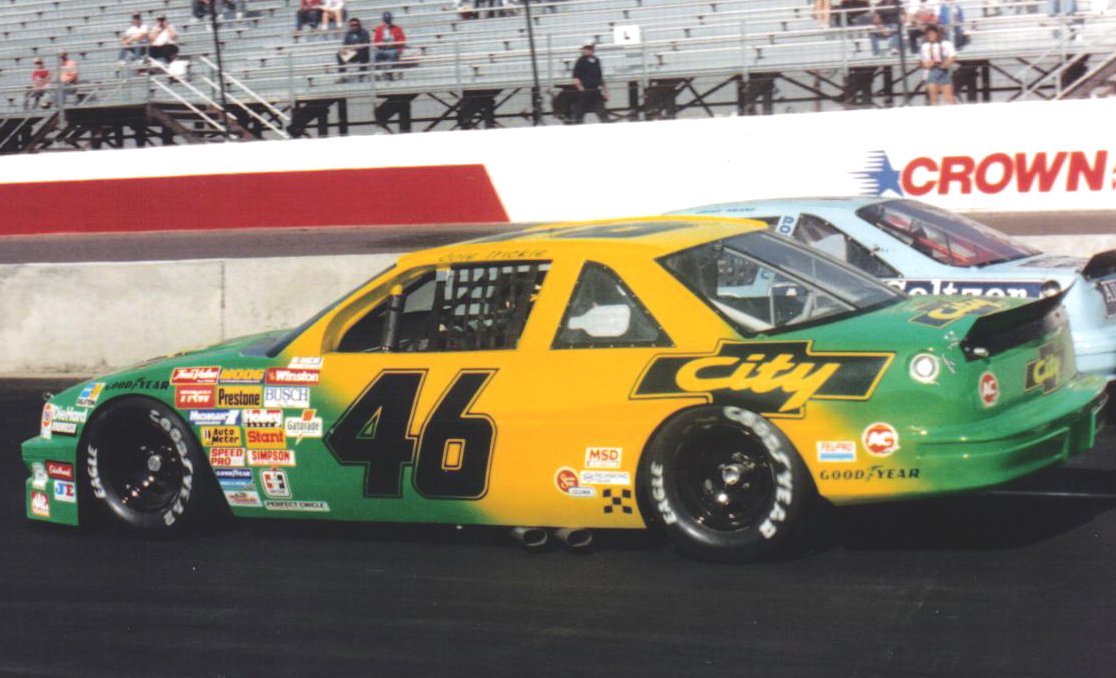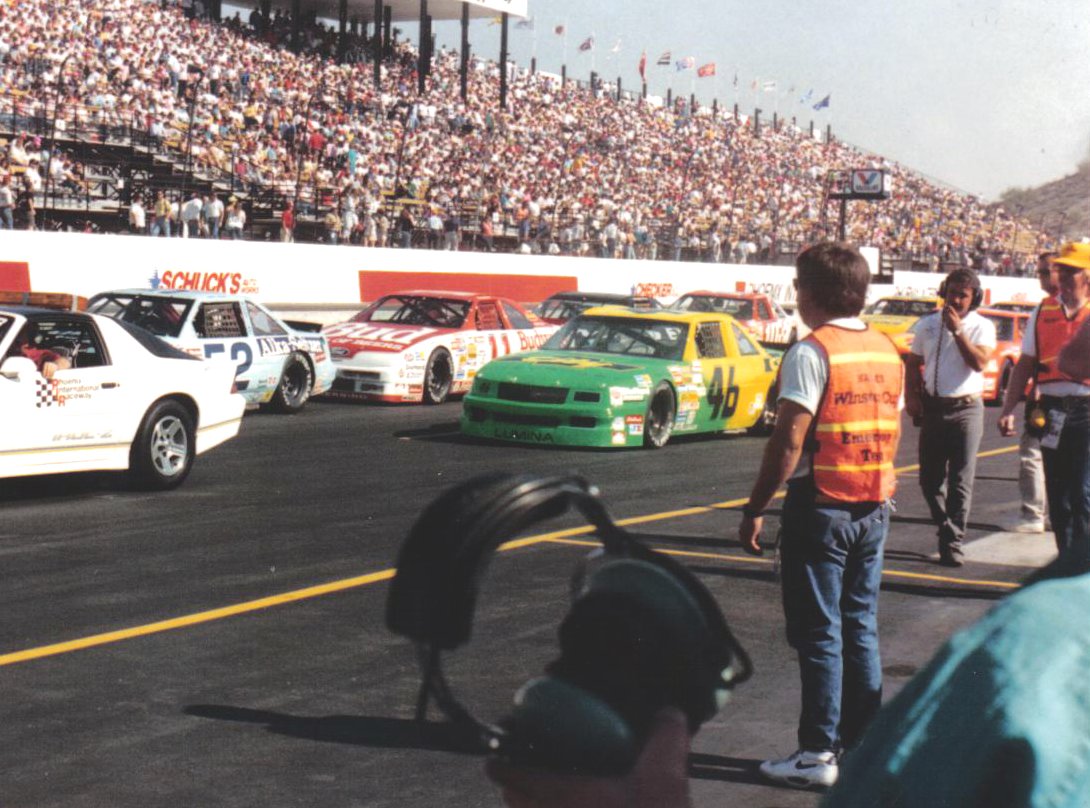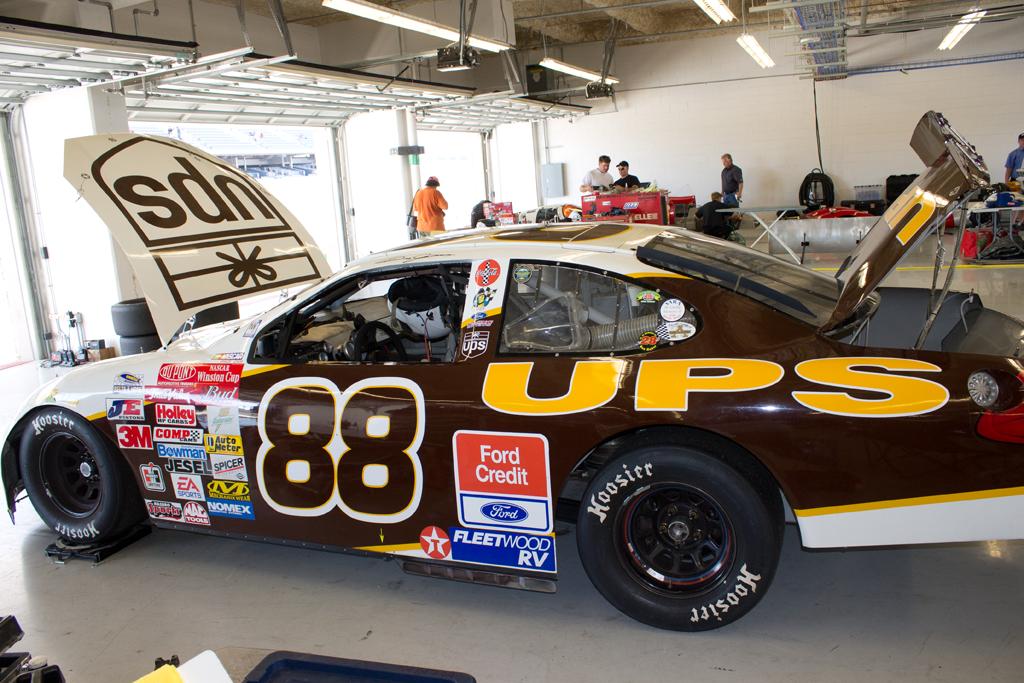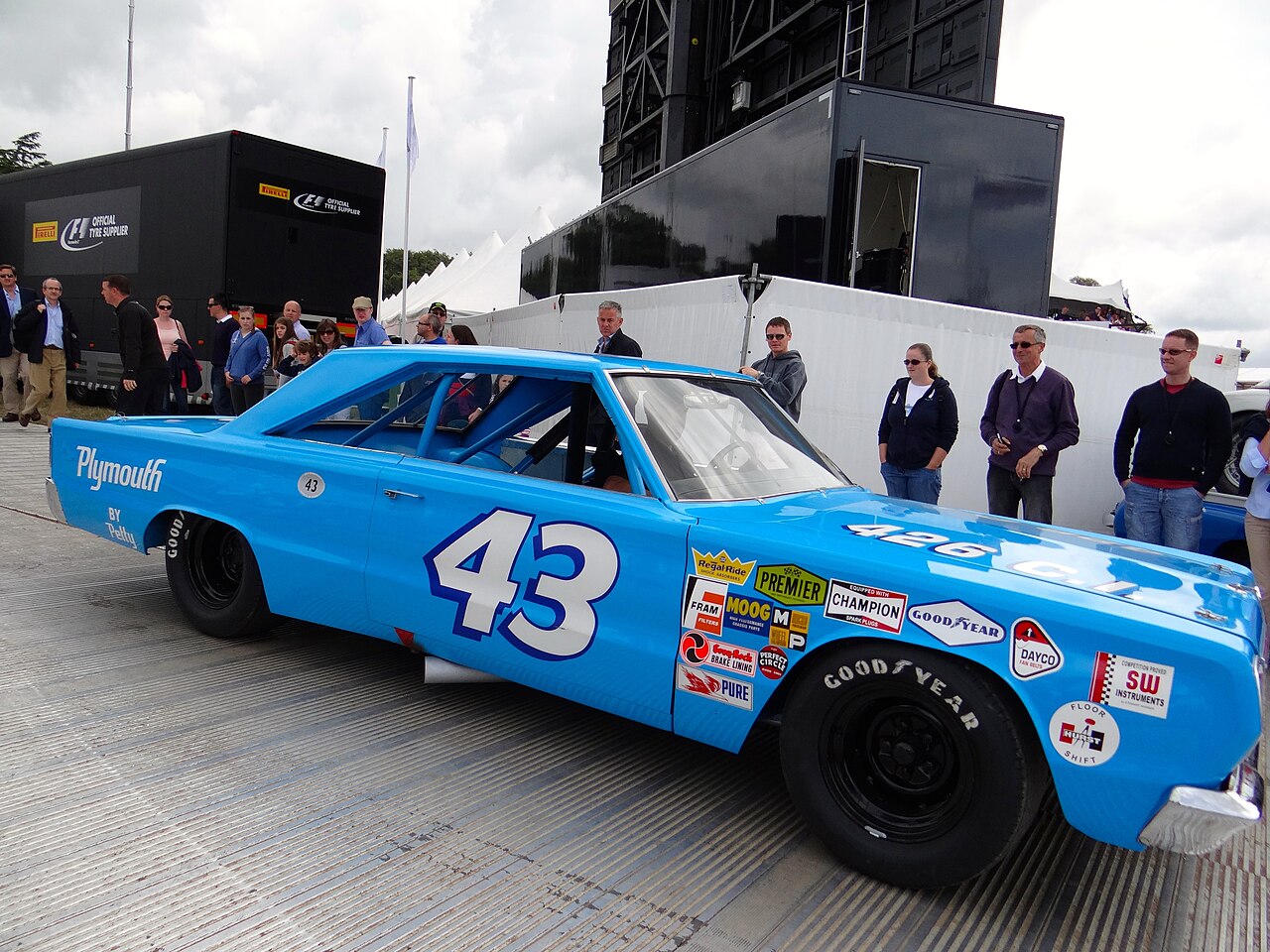Collecting NASCAR Race Cars
The “SC” in “NASCAR” stands for “stock car,” but nowadays you can’t walk into your local dealership the day after a race and say, “I want one of those!” NASCAR rules have long required a common chassis, so no more modified stock cars. But carmakers still take heed.
For a long time, NASCAR rules required the same models in its races to be stocked in dealerships, meaning car collectors can still find some NASCAR models on the resale market. Either way, here are NASCAR's most iconic cars from the racetrack.
![]()
The Chevy Impala
In 1963, you could order a Chevy Impala that was the same as the Cup version (after some tweaking), but not so when the Impala reappeared in 2007 as Chevy’s version of NASCAR’s Car Of Tomorrow, winning Jimmie Johnson four drivers’ championships and Tony Stewart one.
 Freewheeling Daredevil, CC BY 2.0, Wikimedia Commons
Freewheeling Daredevil, CC BY 2.0, Wikimedia Commons
The Chevy Monte Carlo
The Chevy Monte Carlo’s 396 wins far outpaces the competition, partly from being around so long, racing at various points between 1971 and 2007. Its successes include all of Jeff Gordon’s four Cup victories. Particularly in the 1980s, the Monte Carlo was famed for its boxy right angles.
The Chevy Monte Carlo
In 1995 a new, sleek Monte Carlo showed up with aerodynamic curves that helped Dale Earnhardt win his very first Daytona 500 three years later. This radical shift from squarish to wind-friendly contours pushed competitors to follow suit, with eagle eyes set on rising spoilers.
 BWard 1997, CC BY 4.0, Wikimedia Commons
BWard 1997, CC BY 4.0, Wikimedia Commons
The Chevy Lumina
Earnhardt also took a Chevy Lumina to many of its 61 successes, including at the Atlanta 500 in 1994, in the process tying a record for wins at the race track. But the Luminas—and NASCAR—scored an earlier victory thanks to a certain Hollywood star’s race to the box office.
 James Phelps, CC BY 2.0, Wikimedia Commons
James Phelps, CC BY 2.0, Wikimedia Commons
Days Of Thunder (1990)
Even if some see it as an overproduced retread of Tom Cruise’s Top Gun (1986), Days Of Thunder raised NASCAR’s image after management and its teams put a lot of work into the film, including filmed races, while Cruise’s Cole Trickle also boosted the profile of the Chevy Lumina.
 us44mt, CC BY-SA 2.0, Wikimedia Commons
us44mt, CC BY-SA 2.0, Wikimedia Commons
Days Of Thunder (1990)
In 2024 it was reported that two cars used in the film had been discovered in two separate forest areas in Florida. One of them appears to be the Lumina used by Cruise in the movie’s final scene. Unfortunately, to the chagrin of collectors, both cars seem too far gone to be restored.
 us44mt, CC BY-SA 2.0, Wikimedia Commons
us44mt, CC BY-SA 2.0, Wikimedia Commons
Ford Fairlanes
Switching lanes to Ford, we have its challenge of an unrelenting Kiekhaefer team (more on them later) and their Chrysler 300Cs, but the Fairlane squeezed in some wins from 1956 to 1959, driven by Fireball Roberts, Curtis Turner, Ralph Moody, and Marvin Panch.
Ford Galaxies
A range of Galaxies, including some with giant 427 cubic inch (7 liter) V8s, propelled Fred Lorenzen, Ned Jarrett, and Dan Gurney to triumph at the finish line. Holman & Moody and Junior Johnson helped outfit these cars that made headlines on NASCAR tracks in the 1960s.
 Morven, CC BY-SA 3.0, Wikimedia Commons
Morven, CC BY-SA 3.0, Wikimedia Commons
The Ford Torino Talladega And Mercury Cyclone Spoiler II
The aerodynamic Ford Torino Talladega and Mercury Cyclone Spoiler II were Ford’s weapons in the battle against racing drag, the villain in the wind of the late 1960s. The Mercury matched the Plymouth Superbird’s eight Grand National wins in 1969 and 1970, and the Torino had 29 wins.
 Sicnag, CC BY 2.0, Wikimedia Commons
Sicnag, CC BY 2.0, Wikimedia Commons
Ford Thunderbirds
Ford Thunderbirds’ smooth aerodynamics and powerful motors rode to victories in the decade starting in 1978. Racing giant Bill Elliott drove one to nearly 213 mph in a qualifying lap, a Cup record. And the racing version still looked like the car you could buy at your Ford dealer!
 Chris Short, CC BY-SA 2.0, Wikimedia Commons
Chris Short, CC BY-SA 2.0, Wikimedia Commons
Ford Taurus
Ford replaced the Thunderbird with its Taurus, but the four-door coupe required NASCAR’s special permission. Although two doors were yanked out, it was the exception that proved the rule that buying a NASCAR model in your local showroom would soon be a thing of the past.
 Brian Snelson, CC BY 2.0, Wikimedia Commons
Brian Snelson, CC BY 2.0, Wikimedia Commons
Ford Fusion
Replacing the Taurus as Ford’s NASCAR nameplate in 2006, the Fusion took the carmaker to its 1000th win across the top three series in 2013, with driver Greg “The Biff” Biffle at the wheel. By the time Ford retired the car from NASCAR in 2018, the Fusion had clocked 108 Cup wins.
 Bo Nash, CC BY-SA 2.0, Wikimedia Commons
Bo Nash, CC BY-SA 2.0, Wikimedia Commons
Dodge Intrepid, Charger, Magnum, And More
Chrysler Dodges managed 217 victories in their time, with model lines including the Intrepid, Charger, Magnum, and Avenger—suitable names for these feisty cars, which won their last Cup championship in 2012 after the Penske team announced they were switching to Ford.
Plymouth Superbird
Based on the Plymouth Road Runner, this surprise Superbird model was the carmaker’s successful attempt to lure driver Richard Petty back for the 1970 season. He’d been unhappy with the Road Runner’s performance, and wanted Plymouth to come up with a “winged” option.
Plymouth Superbird
Taking its cue from Dodge’s aerodynamically advanced Charger Daytona, designed by an actual rocket scientist, Plymouth engineers took out the ugly, kept the body sleek, but added greater downforce potential, powered by a big-block Hemi V-8 engine with lots of torque.
Plymouth Superbird
Petty returned to the Plymouth team, and the car did great, but its reign was brief. NASCAR admitted its safety standards couldn’t handle 200 mph, so required weaker motors or greater weight to slow things down. Plus more NASCAR rule changes sealed the Superbird’s fate.
Plymouth Superbird
This was still an era when NASCAR took the “stock” in “stock car” seriously, ajd so required carmakers to make 500 copies of each car in competition. But few people wanted to buy this “ugly duckling,” and NASCAR then increased the numbers Plymouth would have to make.
 ckirkman, CC BY 2.0, Wikimedia Commons
ckirkman, CC BY 2.0, Wikimedia Commons
Plymouth Superbird
Now considered the “Holy Grail” by many classic car collectors, the Superbird generates lots of interest on the resale market. In 2019 a seller rejected a bid of $3.5 million for Petty’s 1970 Plymouth Superbird. (Actually, all Superbirds are from 1970 as they came and went so fast!)
 Skeensss, CC BY-SA 4.0, Wikimedia Commons
Skeensss, CC BY-SA 4.0, Wikimedia Commons
The Toyota Camry
Toyota likes to say it “races what it sells,” and considering how well its Corolla sells, the carmaker’s commitment to the Camry on the NASCAR track makes sense, winning 27 races since 2022, placing the model line third in the current seventh generation of NASCAR specs.
 TaurusEmerald, CC BY-SA 4.0, Wikimedia Commons
TaurusEmerald, CC BY-SA 4.0, Wikimedia Commons
The Hudson Hornet
Back in the 1950s, the Hudson Hornet won 66 races over three seasons, a record lasting years. Herb Thomas and other drivers took advantage of a car that was neither heavy overall nor top-heavy, supported by a sharp team from Hudson, which merged to form AMC in 1954.
 JazzyJoeyD, CC BY-SA 4.0, Wikimedia Commons
JazzyJoeyD, CC BY-SA 4.0, Wikimedia Commons
The Hudson Hornet
The Hornet won a total of 79 races, with one driver, Herb Thomas, sometimes seated alongside Jocko Flocko, his pet monkey. But even more Hollywood is the animated feature Cars, which came out in 2006 and featured Paul Newman’s voice behind a talking 1951 Hudson Hornet.
 Greg Gjerdingen, CC BY 2.0, Wikimedia Commons
Greg Gjerdingen, CC BY 2.0, Wikimedia Commons
Buick Regals
When the top tier of NASCAR racing was still called the Winston Cup, Darrell Waltrip was crowned champion in 1981 and 1982, and Bobby Allison in 1983, all driving Regals to victory. Although long gone from NASCAR, at least Buicks are still seen on the roadway, if not the raceway.
 Ted Van Pelt, CC BY 2.0, Wikimedia Commons
Ted Van Pelt, CC BY 2.0, Wikimedia Commons
The Chrysler 300C
“EC” Kiekhaefer’s drivers rode superslick Chrysler 300Cs to victory with astonishing frequency. Tim Flock won 18 races in 1955, and a championship, while Buck Baker won a crown the next year. It helped that Kiekhaefer was a millionaire who could buy the best cars—and drivers.
 Jeffrey Hayes, CC BY 2.0, Wikimedia Commons
Jeffrey Hayes, CC BY 2.0, Wikimedia Commons
The Chrysler 300C
Founder of the Mercury boat-motor business, Kiekhaefer wanted publicity—the good kind. But things turned sour when competitors accused the winningest team of irregularities. In retrospect, the grousing looks like sour grapes, but the millionaire packed it in and returned to Wisconsin.
 Corvair Owner, CC BY-SA 2.0, Wikimedia Commons
Corvair Owner, CC BY-SA 2.0, Wikimedia Commons
Mercury Montego
Aerodynamically smooth, the Montego ended its NASCAR run from 1972 to 1976 in spectacular fashion with David Pearson’s victory at the Daytona 500 after Richard Petty crashed. Part of the Montego’s success has been attributed to a sleek rear deck, enhancing the car’s aerodynamics.
 Ted Van Pelt, CC BY 2.0, Wikimedia Commons
Ted Van Pelt, CC BY 2.0, Wikimedia Commons
Pontiacs
Another model line long gone from NASCAR—and the new car market—is the Pontiac. NASCAR driver Rusty Wallace racked up 31 wins and the 1989 title in a Pontiac, with the year 2000 marking the last time the title was won by a Pontiac, that time driven by Bobby Labonte.
 us44mt, CC BY-SA 2.0, Wikimedia Commons
us44mt, CC BY-SA 2.0, Wikimedia Commons
Oldsmobiles
Oldsmobiles scored their longest list of wins in 1951 thanks to drivers Curtis Turner, Herb Thomas, and the three Flock brothers. Lee Petty won the 1959 championship in an Olds, and his son Richard along with Cale Yarborough rode Oldsmobiles for some of their 1970s races.
 Supermac1961, CC BY 2.0, Wikimedia Commons
Supermac1961, CC BY 2.0, Wikimedia Commons
AMC Matadors
The Matador scored five wins in Cup races from 1973 to 1975, each victory with either Mark Donohue or Bobby Allison at the wheel. The Matador made its first appearance at NASCAR in 1972 when Roger Penske raced in the car. But the model line was discontinued in 1978.
 Christopher Ziemnowicz, CC BY-SA 4.0, Wikimedia Commons
Christopher Ziemnowicz, CC BY-SA 4.0, Wikimedia Commons
The Ford Lincoln
Ford’s higher-end line-up of Lincolns made their first appearance in NASCAR’s very first year of racing in 1949, and would win four Cup races over the next two seasons. Curiously enough, in 1996 the Lincoln “almost” returned to NASCAR, but Ford chafed at the demand for more testing.
 Sidney Reilly, CC BY 2.0, Wikimedia Commons
Sidney Reilly, CC BY 2.0, Wikimedia Commons
Studebaker
Frank Mundy won two of the three Cup races that Studebaker ever won, and all three wins were in the 1951 season. The first race the Indiana-based carmaker (long defunct) won was on a half-mile dirt track in Cayce, South Carolina. After 1951 Mundy never won again—in any car.
 Freewheeling Daredevil, CC BY 2.0, Wikimedia Commons
Freewheeling Daredevil, CC BY 2.0, Wikimedia Commons
Nash
Nash was another carmaker briefly in the spotlight during NASCAR’s rough-and-tumble early days, with Curtis Turner winning the company’s only victory—on a 3/4-mile dirt track at the Charlotte Speedway—in 1951. Nash and Hudson merged three years later to form AMC.
 Mike Kalasnik, CC BY-SA 2.0, Wikimedia Commons
Mike Kalasnik, CC BY-SA 2.0, Wikimedia Commons
Jaguar XK120
In 1954, an unusual race was held on an airport track at Linden, New Jersey. Thirteen Jaguars entered, and Al Keller’s Jaguar XK120 won the 21-car competition. His win was likely helped by the Jag’s aluminum body, making it a quick and nimble vehicle by the standards of the time.
 Lothar Spurzem, CC BY-SA 2.0, Wikimedia Commons
Lothar Spurzem, CC BY-SA 2.0, Wikimedia Commons
NASCAR: The Seventh Generation
NASCAR’s latest “seventh generation” of competing car models began in 2022. With similar looks, it’s unlikely any of the cars have become “iconic” yet, but it’s worth noting that the pecking order of wins looks familiar: Chevy Camaro at 52, Ford Mustang at 30, and Toyota Camry at 27.
 TaurusEmerald, CC BY-SA 4.0, Wikimedia Commons
TaurusEmerald, CC BY-SA 4.0, Wikimedia Commons
Chevrolet Vs Ford Models
Publicity and bragging rates must count for something. Statistics change, but Chevy’s been in the lead for years, its 866 wins easily outdistancing runner-up Ford’s 740. But Ford fans still point to past victories and harbor future hopes, with both sides scooping up the merchandise.
 Calreyn88, CC0, Wikimedia Commons
Calreyn88, CC0, Wikimedia Commons
Dodge Models
Third place goes to Dodge, which racks up a pretty measly 217. But keep in mind the carmaker has long been out of the NASCAR game, last dropping out in 2012, after also exiting in 1977. Its parting NASCAR win was a Dodge Charger driven by Brad Keselowski on September 30, 2012.
Plymouth Models
In fourth place with 191 wins is Chrysler’s old division Plymouth, whose Superbird fell prey to NASCAR’s stricter safety guidelines in 1971, partly aimed at reducing the high speeds sported by “aero” cars. Plymouth won its last race in 1973 before driving off into the NASCAR sunset.
 Phil Guest, CC BY-SA 2.0, Wikimedia Commons
Phil Guest, CC BY-SA 2.0, Wikimedia Commons
Toyota Models
Just two wins behind frozen-in-time Plymouth, Japanese giant Toyota is still in fifth place, but likely not for long. Only one of three carmakers currently engaged in NASCAR, the automaker joined Cup competition in 2007, with its Toyota Camry making the first of its 189 wins in 2008.
 Alf van Beem, Wikimedia Commons
Alf van Beem, Wikimedia Commons
Taking Stock
From dirt roads and impromptu modifications, NASCAR racing has come a long way, improving its safety requirements, but leaving behind much of the tradition of the “stock car”. While manufacturers have come and gone—mostly gone—future icons may yet overtake past titans.














